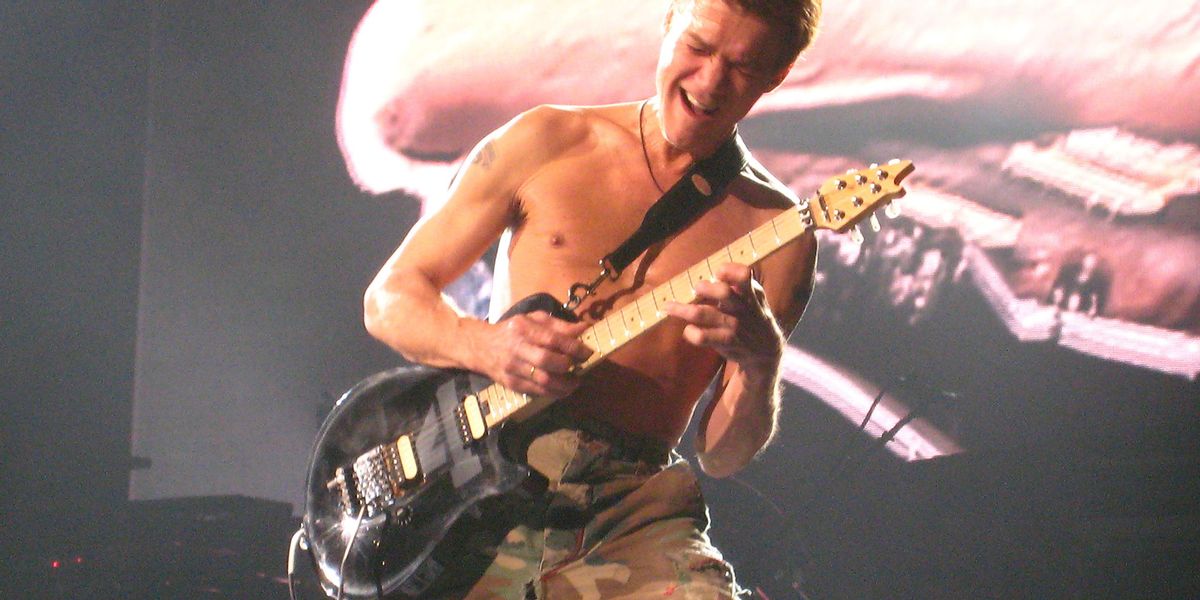From the ages of 13 to 18, every square inch of my bedroom walls were wallpapered with posters and pictures, clipped from rock fanzines like Circus and Hit Parader, of Kiss, Aerosmith, AC/DC, Def Leppard, Mötley Crüe, Iron Maiden, and a couple-dozen other shag-haired, lipstick-and-leather heavy-metal heroes. But one whole corner of the room (the southwest one, because LA), was dedicated exclusively to posters, pages, and magazine cutouts—a floor-to-ceiling two-wall collage—of Eddie Van Halen.
You see, I was born at the right time, coming of age when the six-string giants still roamed and ruled the land. Every kid I grew up with wanted an electric guitar and dreamed about all of the things it would bring them. If we found anyone who actually owned and could play one, we would sit and watch in wonder and adoration for as long as he would let us. Then we would run home and practice on our tennis rackets until we got it just right.
The real guitar wizards I listened to all night in my bedroom (the kid was into losing sleep) on worn-out cassette tapes seemed like illusory figures from some realm that I could visit only in my wild rock and roll fantasies. When I heard that Jimmy Page cut a deal with the devil or that Ace Frehley came from another planet, I figured it must be true, otherworldly as these titans seemed to be. And at the top of the pantheon of almighty guitar gods was, of course, Eddie Van Halen.
Guitar gurus will break down the technical mastery of Eddie's playing, how those drop-D tunings and suspended fourths on "Unchained", for instance, revolutionized rock guitar forever. But as a kid, I didn't need to understand any of that to know that Eddie Van Halen split the atom. The fact that I had no idea how he could possibly be conjuring those sounds out of a guitar was a massive part of the could-this-be-magic fascination with the incredible rush of sounds pouring through my speakers and into my imagination.
The finger-tapping, the harmonics, the tremolo picking, the divebombs, the thrilling velocity. The squeals, the squawks, the whinnies, the buzzes, the whole damn menagerie. If Hendrix threshed up rock guitar on a tractor, Eddie showed up a decade later driving a combine two stories tall. He was an experimental modernist whose playing, much like the Frankenstrats he built, gave rise to whole new sonic worlds, wrote an original language for guitar vernaculars, incinerated all the rulebooks, and lit up the sky. Everybody wanted some.
Still, Eddie's mad-scientist trailblazing would have remained solely the fixation of guitar geeks and gearheads had it not been for his other superpower: his brilliant gift for melody. He turned chord progressions and scales inside out, created cadenzas and sonatas in 16 breakneck measures, and built not only the rock architecture that would rule the atomic punks but also the sinner's-swing boogie licks that made the beautiful girls dance the night away.
Still, despite his brain-liquefying musical prowess, Eddie always felt reachable. He seemed normal. He had no use for the makeup, the schoolboy suits, the capes, the codpieces. He was just a cool California kid with long hair who wore overalls and a stoner's grin. Eddie seemed carefree, quiet, unpretentious, sort of shy, a guy who cracked himself up blowing smoke rings, who had no problem ceding the spotlight to David Lee Roth's vaudeville antics.
So he came across as a guy we could be like. But our chances of playing the guitar like him were the same as our chances of marrying Valerie Bertinelli. All that our cool uncles had to do to impress their friends was figure out how to play the "Smoke on the Water" and "Purple Haze" introductions. We were up against "Eruption" and "Spanish Fly". That's why Eddie Van Halen spawned millions of imitators and zero equals.
So most of us settled for listening to him play and allowing the sound of Eddie's guitar to represent all of the things that rock and roll music made us feel and made us crave more of. All of the things I wanted to be and wanted to do, all of the stuff of rock dreams--the escape, the rebellion, the love, the sex, the communion, the immortality of youth, the altered states, the city lights, the endless nights, the blood brothers -- all of it was found in Eddie's solo on "Ice Cream Man".
During the years that I spent drawing the Van Halen logo on my school notebooks, I wasn't old enough to transport myself 200 miles to a Van Halen concert. But finally, in July 1988, one of the Springfield, Missouri, radio stations made it easier: They sold tickets to see Van Halen in Kansas City, a package that included not only a ticket to the show but also a bus ride up there and back. Van Halen were headlining the Monsters of Rock tour, an all-day, outdoor, hard-rock blowout with the Scorpions and Metallica. The members of my high-school rock band (we covered "You Really Got Me" and "Ain't Talkin' 'Bout Love") all scored tickets for what we knew would be a metal marathon for the ages.
A lot happened that day, but it all pales into puniness compared to the last hundred minutes of the event, when I positioned myself on the field at stage left (Eddie's side, of course) for Van Halen. There I stood, a few yards away from Eddie Van Halen, brought miraculously to sinewy, shredding, herkie-ing, retina-burning, eardrum-rupturing real life. To a kid who had gone to sleep a thousand consecutive nights in the shadow of his posters, it was like getting hit with a comet.
Thank you for your life, Eddie Van Halen. Long live the music, the joy, and all the little dreamers you inspired.
